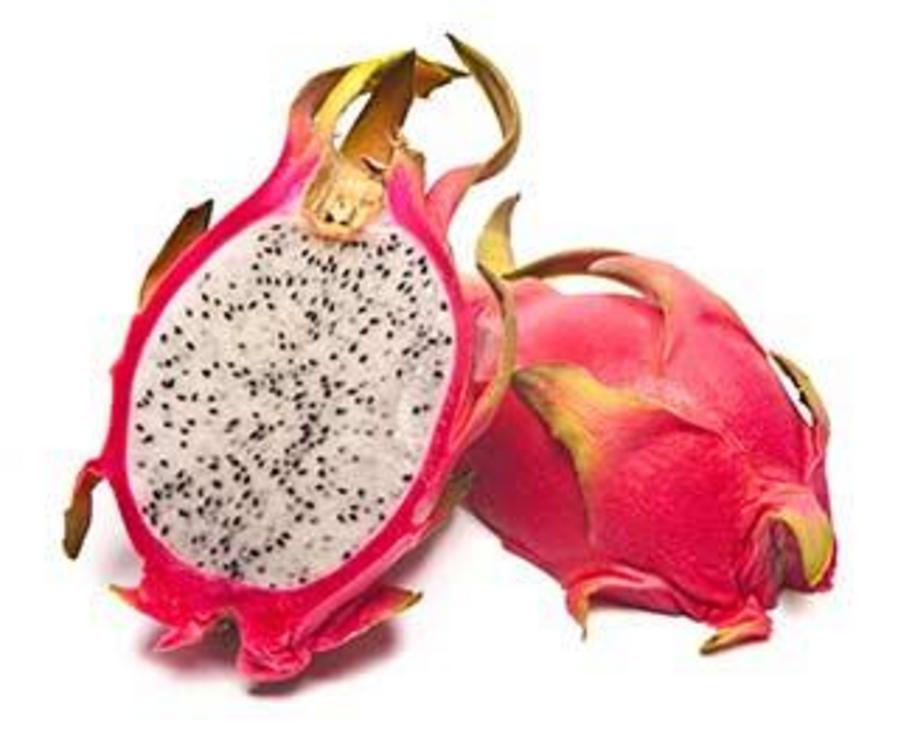What is dragon fruit good for?
The pitaya is one of nature’s most unique plants, with a flower like an explosion of flame and a fruit like a pink rosebud. Widely known as dragon fruit, it is indigenous to Central America but is also grown and exported from several Southeast Asian countries, such as Thailand and Vietnam.1 The dragon fruit is actually one of several cactus species and, just like its relatives, has a succulent stem that provides a uniquely delicious fruit with moisture in the arid climates where it typically grows.2
Dragon fruit looks like a soft pineapple with spikes, and can have either pink, red or yellow skin and white or red flesh. The fruit also has overlaid or scale-like leaves, similar to an artichoke,3 and an abundance of small, black edible seeds. Its flavor is mildly sweet, like a blend of kiwifruit and pear, and has a crunchy texture.4
While the fruit may seem a little strange at first, it's easy to prepare. Begin by slicing the dragon fruit lengthwise. Afterward, you can remove the flesh, or slice the fruit further into quarters and peel the leathery skin. Make sure that you only eat the white part containing the seeds, and discard any remaining pink portions, as they tend to be bitter.5
Health Benefits of Dragon Fruit
Dragon fruit contains a surprising number of phytonutrients.6 It is also loaded with antioxidants,7 and is home to carotene, protein, vitamin C (said to be near 10 percent of the daily recommended value), polyunsaturated (good) fatty acids and B vitamins that may be needed for carbohydrate metabolism .8,9 In addition, this tropical fruit doesn’t contain complex carbohydrates, which may allow vitamin B1 (thiamin) along with other B vitamins in the body to break down food more easily in the body.10
The dragon fruit is also a source of other nutrients like calcium that may help develop strong bones and teeth, iron that may assist in forming healthy red blood cells, and phosphorus to aid in promoting tissue and cell growth, maintenance and repair.11,12
A phytochemical called captin is present in dragon fruit too. It is typically used in medicines that may help alleviate heart problems. Other known benefits of dragon fruit include boosting the immune system, promoting quicker recovery from wounds and bruises, and reducing the risk for respiratory problems.13
Eating dragon fruit may also help the body maintain its normal function by helping eliminate toxic heavy metals14 and improving eyesight.15 Lycopene, responsible for the fruit’s red color,16 has been linked with a lower prostate cancer risk.17 Meanwhile, seed extracts from dragon fruit are high in polyunsaturated fats (omega-3 and omega-6 fatty acids)18 that may help reduce triglyceride levels19 and lower the risk of cardiovascular disorders.20 In some cases, oil derived from the seeds may serve as a mild laxative too.21
Make sure to consume dragon fruit in moderation because it contains fructose, a type of sugar that may be harmful to your health if consumed in excessive amounts.
Dragon Fruit Nutritional Facts
Serving Size: 3.5 ounces (100 grams), fresh22
Amt. Per
Serving% Daily
Value*
Calories60
Calories from Fat0
Total Fat0 g
Saturated Fat
Trans Fat
Cholesterol0 mg
Sodium
Total Carbohydrates12.94 g
Dietary Fiber1 g
Sugar7.65 g
Protein1.18 g
What Do Studies Show About Dragon Fruit?
Some studies have already been conducted to determine if dragon fruit plays a role in improving overall health and well-being. One example is a 2011 study from the Asian Pacific Journal of Cancer Prevention, where researchers assessed the relationship between a healthy diet containing fruits and vegetables, lifetime physical activity and oxidative DNA damage linked to prostate cancer .
The conclusion was that exercise and a diet of fresh fruits and vegetables, especially those containing lycopene like dragon fruit, were found to be protective against the disease.23
Another study published in Drug Metabolism and Disposition in 2004 aimed to learn more about the capacities of tropical fruits like dragon fruit, since there is limited information surrounding them. The study yielded positive results, and the researchers discovered that tropical fruits like dragon fruit may inhibit the activity of the human cytochrome P450.24
This substance can often be seen in the liver, but may also be found in other tissues such as in the small intestine, lungs and kidneys, and mutations of this particular substance have been associated with development of congenital glaucoma.25
Dragon Fruit Healthy Recipe:
Truly Tropical Fruit Dragon Fruit Smoothie Bowl Recipe

Ingredients:
2 cups frozen dragon fruit cubes
1/3 cup plain Greek yogurt or raw grass fed yogurt
1 banana
Procedure:
- In a blender, liquefy the ingredients.
- Serve into two bowls (or freeze half of the portion for later).
- Add toppings of choice and enjoy.
This recipe makes 2 servings.
Preparation/total time: 10 minutes
One of the main reasons that dragon fruit is so unique is because the plant tends to live only for one night! First, a climbing cactus produces beautiful pink or yellow flowers.26 Once these flowers bloom from evening to midnight, they are pollinated by moths and bats.27 Before dawn hits, the flowers wither and die . This event is a major reason why dragon fruit is sometimes called "moonflower," “lady of the night.”28
Summary
Dragon fruit is low in calories, yet offers numerous nutrients, including vitamin C, B vitamins, phosphorus, protein, calcium, captin and antioxidants. It has been proven to help lower blood pressure levels, strengthen bones and teeth, promote healthy blood and tissue formation, strengthen the immune system, heal bruises and wounds faster, and inhibit health problems in your respiratory system.
Like other red fruits, dragon fruit contains lycopene, which may assist in reducing your risk for cancer or heart disease. It's best eaten chilled, chopped into cubes 30,31 and added to fruit salad or blended into a refreshing drink or smoothie. This may become your new favorite fruit, and you don't even have to slay a dragon.
For full references please use source link below.

